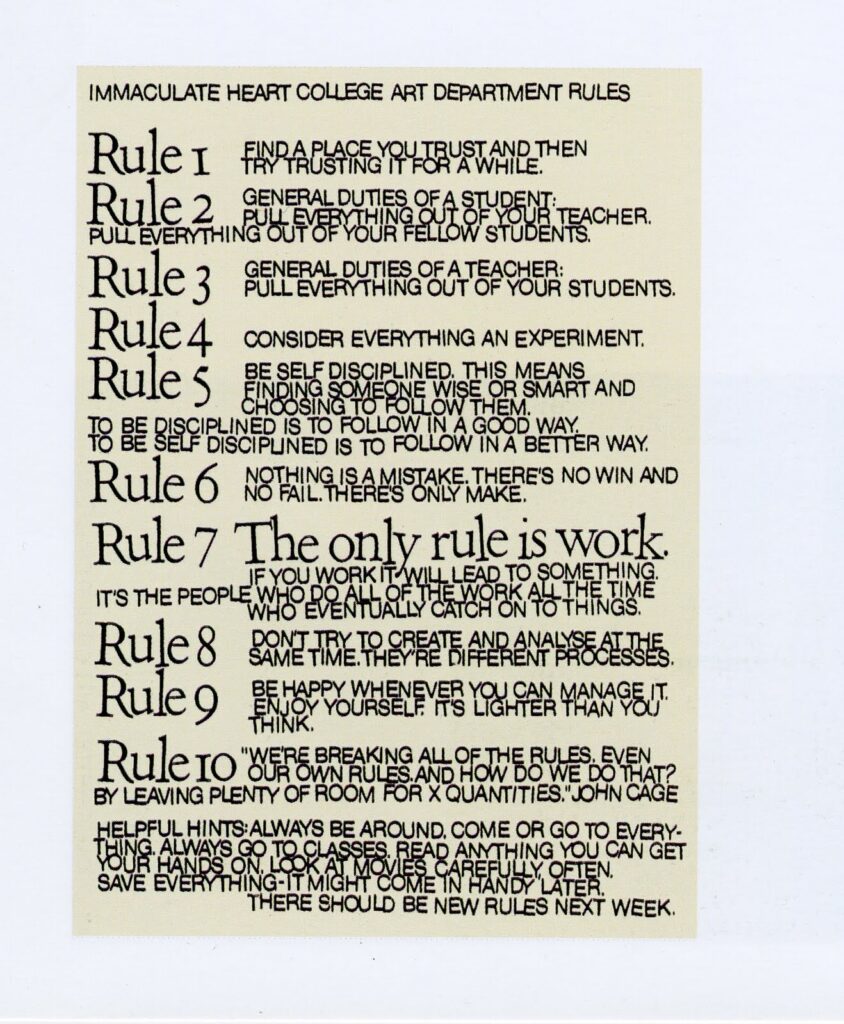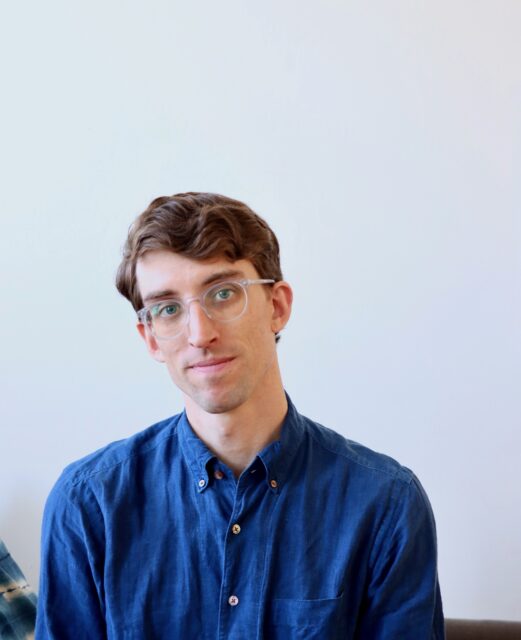Last semester when I was researching the artist Bethany Collins, I stumbled upon an article published on Artforum. The author of this article was Davidson alum, Brian T. Leahy. A few weeks ago, I had the opportunity to interview Mr. Leahy, who generously shared his experience in Davidson and post-Davidson.
Leahy received B.A. in religious studies and studio art at Davidson in 2011. After graduation, he landed in a non-profit in Asheville, North Carolina. With an interest in working in museums, he then went on to pursue a master’s degree in art history at the School of the Art Institute of Chicago (SAIC). Leahy is currently finishing his Ph.D. in Modern and Contemporary Art History through Northwestern University, located just outside of Chicago. At the same time, he has been working as an art critic and has held fellowships at the Morgan Library & Museum in New York, the Menil Collection in Houston, and the Art Institute of Chicago. In the following interview, Leahy discusses how he discovered what he wanted to do while exploring the arts industry and negotiated between his multiple roles as scholars, critics, and artist. Over the course of the interview, he offered great advice for current students interested in pursuing graduate education and a career in the arts.
- Sarah Zhang: Can you share with us how you discovered that the career you are pursuing now is the right choice for you? What are some factors/events that really influenced your career trajectory?
Brian T. Leahy: “When I was at Davidson I was double majoring in studio art and religious studies, so I was interested in making things as well as research and writing. I remember even as a sophomore, I’d always hang around when the seniors were installing their senior exhibition and offer to help when they needed another hand. I really love the process of putting together a show. Early on I thought I wanted to work in museums, so I went to SAIC and worked on a lot of exhibitions while getting my masters in art history. But, through writing the master thesis, I found myself intrigued by long-form research and writing projects, eventually landing where I am now. I found my path by encountering great mentors and teachers along the way who encouraged me and helped me to keep looking in that direction.”
- Sarah Zhang: How did your experience at Davidson influence your career path? What was your favorite part about being in Davidson? What courses or skills that you picked up here helped you move forward in your career?
Brian T. Leahy: “I think being a studio major at Davidson, I had a lot of freedom to explore what I wanted to do and provided many resources. I have been in a lot of art school environments since then, and I still think that the print shop at Davidson was the best one I’ve seen. For example, the ability to run a lithographic press yourself at 10 p.m. on a Tuesday is a rare opportunity. I like to think of my writing now as very invested in the perspective of the artist and their material processes. So for me as a writer, having that training as a studio art major was really important. But I also think that the student senior exhibition and having a chance to work in the gallery and those kinds of hands-on opportunities were also crucial.
And the other part of being a studio art major was spending a lot of time in the library looking at exhibition catalogs, trying to understand what other artists had made. I think this kind of self-directed but rigorous education, as well as the conversations I had with other peers, friends, and artists at Davidson, were the main important things that influenced me.”
- Sarah Zhang: What is your Ph.D. experience like? Why did you choose to move on to Ph.D.?
Brian T. Leahy: “It’s a rare place in our society to be able to engage with that kind of long-form research and thinking. So I was really excited about that. I also love teaching and I love discussing ideas with students. So that’s going to be my focus after my Ph.D.
The nice thing about a Ph.D. in Art History is that there are two avenues. There is the university route but there is also museum work. I think working in museums and being able to engage with their collections, artists, and objects is also great. At some point, it became clear to me that this was the way to do the many different things I love doing—writing, making exhibitions, teaching, doing intensive research. But this is not always easy to see at the beginning.”
- Sarah Zhang: What is it like working as an art critic?
Brian T. Leahy: “The best part is having an excuse to see a lot of art. It is also the case that for artists, hearing someone respond thoughtfully to what they have made can be an incredibly meaningful experience. Today people are used to looking at many things so quickly. A thoughtful response, whether positive or negative, is a rare thing to receive for artists and something that many of them are looking for. It feels like a great privilege to be able to publish my own response to an artist’s work from time to time.”
- Q: Was there any challenge on your way toward your career and how did you overcome them?
A: “Sometimes the challenge was to figure out which role to pursue at a given moment. After the Art Institute, I worked in galleries for a little while. I liked the work, but I realized I wouldn’t have the time for deep research. That’s when I realized that I wanted to pursue a Ph.D. When I left Davidson I didn’t think I’d go on to Ph.D. at all, especially not in Art History. I thought I wanted to make art.
It often seems that the decision about PhDs or MFAs follows a clear trajectory: you want a certain type of job, so you go and get a certain kind of degree. But the thing is,as you go, there are many ways to do the things you want to do, and sometimes what you want to do might transform. The most successful people are usually those who just get out there and start doing it with or without degrees.
I think I eventually found my path but it wasn’t a straightforward journey. For me, noticing the ways my interests shifted over time and being able to follow them was an evolving process.”
- Sarah Zhang: You have a studio degree and continue to maintain a studio practice as an artist in addition to being an art historian. How do you balance both of these things? How does one inform the other?
Brian T. Leahy: “The relationship between the two is never easy to balance and always evolving. There are times when one takes precedence over the other. For the past couple of years, I was invested in my dissertation. When you stay away from one for too long, you will realize that you need to spend some time on it. And sometimes the two really do go together, like I mentioned before. My experience as an artist really does help me to pay attention to the decisions artists make in the studio.”

- Sarah Zhang: What suggestions do you have for students who are interested in a career path relating to the arts or students at Davidson in general?
Brian T. Leahy: “There is a poster made by Sister Corita Kent for the art department where she taught, Kent was an artist and a nun working on the west coast in the 60s and 70s. One of the rules she included was “come or go to everything.” In other words, go to talks by visiting professors and artists, go to exhibitions, and visit the libraries. I think that is the best advice I would give. Show up and don’t be afraid. If you see work by an artist that you like you can ask if you can visit their studios.
Ultimately it is all out of a love for art. It can be easy to get fixated on certain tasks or milestones, but the most important thing is to keep fueling the love for art, and the way to do that is to see as much as possible.”
- Sarah Zhang: Do you have any suggestions for art history students who are interested in exploring the different positions in the arts and possibly pursuing graduate education?
Brian T. Leahy: “For one, I’d say talk to people who have been there before. For example, talk to faculty members at graduate programs that are interesting to you. Talk to people who have the kinds of jobs you think you might like. Talk with people who are pursuing their Ph.D., before jumping into the application process. The second thing is not to rush. I took a lot of time in between Davidson and my Ph. D., giving myself the time to figure out clearly what I want. A lot of people benefit from having some time to get more experience under their belt. And the third thing would be to keep an open mind. There is a lot of temptation to specialize in one particular area very quickly and figure out exactly what you want to do. But I truly think it is better to keep a broader perspective, and acquire different skills as you go. Art can surprise us, and it is best to be open to the unexpected”
Special thanks to Brian T. Leahy for taking the time to speak to the Davidson College Van/Every Smith Galleries.

